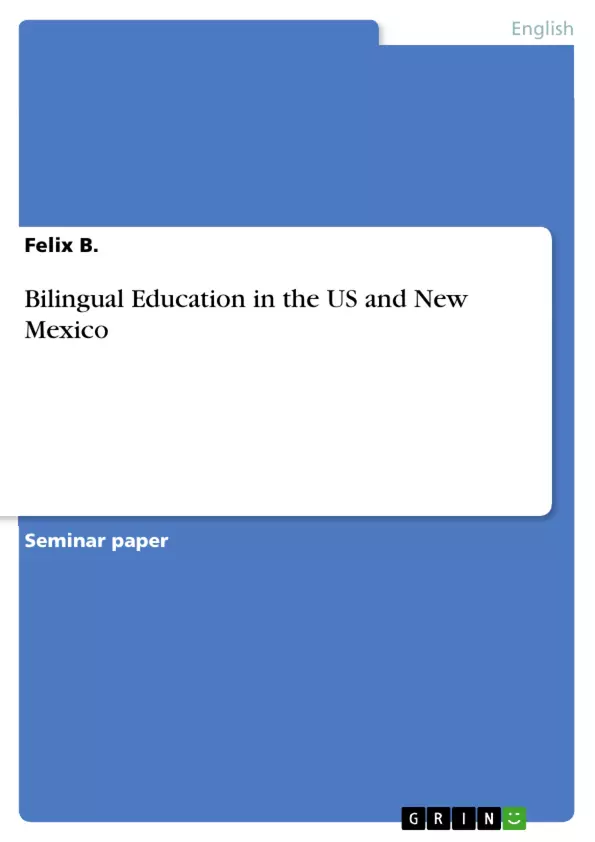The United States is in the midst of a struggle today. It seems that it is only recently that the population has become aware that they are also a multilingual nation. Despite the lack of an official language policy, the country has managed to achieve a very high level of monolingualism. This is part of an assimilationist ideology that decimated the immigrants’ languages as well as the many American indigenous languages.
The focus in this paper is on bilingual education in the United States of America. First of all, there will be given some definitions on several terms. Following this, the paper will provide an overview of the historical development of bilingual education from the beginning until the present. In the second part, the focus will be on Bilingual Education Programs for Hispanics in New Mexico. The paper will describe the development of several Bilingual Education Programs in the Albuquerque School District. The paper is mainly based on secondary literature in the first part and several Internet resources in the second part.
Inhaltsverzeichnis (Table of Contents)
- 1. Introduction
- 2. Terminology
- 3. History of Bilingual Education in the U.S.
- 3.1 The Permissive Period
- 3.2 The Restrictive Period
- 3.3 The Opportunist Period
- 3.4 The Dismissive Period
- 3.4.1 Ronald Reagan
- 3.4.2 George W. Bush
- 3.4.3 Barack Obama
- 4. Bilingual Education for Hispanics
- 4.1 Hispanics in New Mexico
- 4.2 Albuquerque School District
- 4.2.1 Two-way Dual-Language Immersion
- 4.2.2 Maintenance Bilingual Education
- 4.2.3 Enrichment Model
- 4.2.4 Participating schools and student attendance
- 4.3 Bilingual Education and Public Opinion
- 4.4 Research and challenges for the future
- 5. Conclusion
- References
Zielsetzung und Themenschwerpunkte (Objectives and Key Themes)
This paper focuses on the historical development and current state of bilingual education in the United States, specifically examining the experiences of Hispanic communities in New Mexico. The paper aims to provide a comprehensive overview of the different periods and models of bilingual education, highlighting key challenges and opportunities.
- The historical evolution of bilingual education in the U.S.
- The role of language policy and societal attitudes in shaping bilingual education programs.
- The various approaches to bilingual education, including transitional, maintenance, and enrichment models.
- The experiences of Hispanic communities in New Mexico and the implementation of bilingual education programs in the Albuquerque School District.
- The challenges and opportunities facing bilingual education in the future.
Zusammenfassung der Kapitel (Chapter Summaries)
The paper begins by defining key terms such as monolingualism, bilingualism, and multilingualism, establishing a framework for understanding the complexities of language use and education. It then delves into the history of bilingual education in the United States, highlighting four distinct periods: the Permissive Period, the Restrictive Period, the Opportunist Period, and the Dismissive Period. This historical overview provides context for understanding the current landscape of bilingual education and its challenges.
The second part of the paper examines bilingual education programs for Hispanics in New Mexico, specifically focusing on the Albuquerque School District. It explores the implementation of various models, including two-way dual-language immersion, maintenance bilingual education, and the enrichment model. The paper also discusses public opinion and research related to bilingual education, offering insights into the ongoing debate and future directions for this field.
Schlüsselwörter (Keywords)
This paper explores the key concepts of bilingual education, multilingualism, language policy, immigration, and cultural integration in the context of the United States, with a specific focus on Hispanic communities in New Mexico. The paper analyzes various models of bilingual education programs, including two-way dual-language immersion, maintenance bilingual education, and the enrichment model. It also examines the historical development of bilingual education, encompassing periods such as the Permissive Period, the Restrictive Period, the Opportunist Period, and the Dismissive Period.
- Quote paper
- Felix B. (Author), 2013, Bilingual Education in the US and New Mexico, Munich, GRIN Verlag, https://www.grin.com/document/282591



